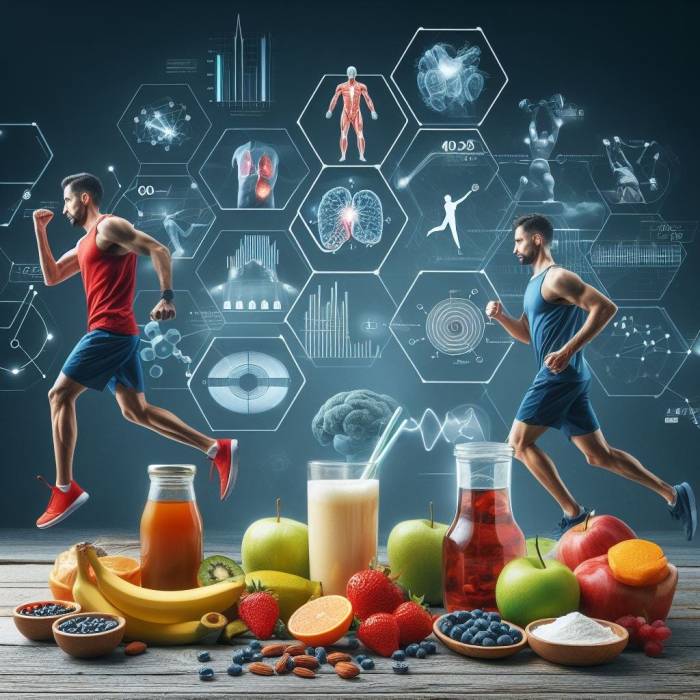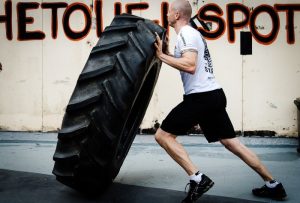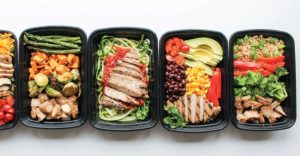
Ever wondered what separates a champion from a contender? Besides sheer grit and a questionable fashion sense, it’s often the unseen fuel: sports nutrition. Forget magic potions and unicorn tears; we’re talking about the science of optimizing your body’s engine for peak performance. This isn’t just about eating; it’s about strategic fueling, a carefully orchestrated symphony of carbs, proteins, and enough electrolytes to make your sweat taste like a refreshing sports drink (almost).
This deep dive into sports nutrition for athletes unravels the mysteries of macronutrients, micronutrients, and hydration strategies. We’ll explore how timing your meals can be as crucial as nailing that perfect jump shot, and delve into the sometimes murky world of supplements – separating fact from fiction and hype from helpful. Prepare to become a nutrition ninja, ready to conquer any athletic challenge with the right fuel in your arsenal.
Macronutrient Needs of Athletes
Fueling athletic performance is a complex balancing act, not unlike juggling chainsaws while riding a unicycle (don’t try that at home!). Getting the right mix of macronutrients – carbohydrates, proteins, and fats – is crucial for optimal training, recovery, and competition. The specific needs, however, vary wildly depending on the sport and the intensity of training. Think of it as a personalized fuel recipe, tailored to your athletic engine.
Macronutrient Requirements Across Different Sports
The macronutrient needs of athletes differ significantly based on the demands of their sport. Endurance athletes, for instance, require a higher proportion of carbohydrates to fuel their prolonged activities, while strength athletes need more protein to support muscle growth and repair. Team sport athletes often fall somewhere in between, needing a balanced approach to support both endurance and strength aspects of their game.
Ignoring these differences is like trying to win a marathon on a bicycle – possible, but not very efficient.
Daily Meal Plans for Different Athlete Types
The following tables illustrate sample daily meal plans, emphasizing the varying macronutrient ratios for different athletic profiles. Remember, these are just examples; individual needs will vary based on factors like body weight, training volume, and individual metabolism. Consult a registered dietitian or sports nutritionist for personalized guidance.
Endurance Athlete Meal Plan
| Food | Macronutrient Breakdown (g) | Serving Size | Timing |
|---|---|---|---|
| Oatmeal with berries and nuts | Carb: 50, Protein: 10, Fat: 15 | 1 cup | Breakfast |
| Banana with peanut butter | Carb: 30, Protein: 8, Fat: 12 | 1 banana, 2 tbsp peanut butter | Mid-morning snack |
| Chicken salad sandwich on whole-wheat bread | Carb: 40, Protein: 30, Fat: 15 | 1 sandwich | Lunch |
| Sweet potato with grilled chicken | Carb: 60, Protein: 40, Fat: 10 | 1 medium sweet potato, 4 oz chicken | Dinner |
Strength Athlete Meal Plan
| Food | Macronutrient Breakdown (g) | Serving Size | Timing |
|---|---|---|---|
| Scrambled eggs with spinach and whole-wheat toast | Carb: 30, Protein: 30, Fat: 15 | 3 eggs, 1 cup spinach, 1 slice toast | Breakfast |
| Protein shake with fruit | Carb: 20, Protein: 30, Fat: 5 | 1 scoop protein powder, 1/2 cup fruit | Post-workout |
| Lean ground beef with brown rice and vegetables | Carb: 50, Protein: 50, Fat: 20 | 4 oz beef, 1 cup rice, 1 cup vegetables | Lunch |
| Salmon with quinoa and broccoli | Carb: 40, Protein: 40, Fat: 25 | 4 oz salmon, 1 cup quinoa, 1 cup broccoli | Dinner |
Team Sport Athlete Meal Plan
| Food | Macronutrient Breakdown (g) | Serving Size | Timing |
|---|---|---|---|
| Yogurt with granola and fruit | Carb: 40, Protein: 15, Fat: 10 | 1 cup yogurt, 1/4 cup granola, 1/2 cup fruit | Breakfast |
| Turkey breast wrap with vegetables | Carb: 30, Protein: 30, Fat: 10 | 4 oz turkey, whole-wheat wrap, vegetables | Lunch |
| Pasta with lean ground turkey and marinara sauce | Carb: 60, Protein: 35, Fat: 15 | 1 cup pasta, 4 oz turkey, 1/2 cup sauce | Dinner |
| Protein bar | Carb: 25, Protein: 20, Fat: 10 | 1 bar | Post-practice snack |
Glycogen Storage and Athletic Performance
Glycogen, the stored form of glucose in the muscles and liver, is the primary fuel source for high-intensity exercise. Think of it as your body’s emergency stash of energy. Adequate glycogen stores are absolutely essential for endurance and high-intensity performance. Depleting glycogen stores leads to “hitting the wall” – that dreaded feeling of fatigue and exhaustion. Maintaining sufficient glycogen levels requires consistent carbohydrate intake, especially before, during, and after intense training or competition.
It’s like keeping your gas tank topped off for a long road trip – you don’t want to run out of fuel when you’re miles from civilization.
Micronutrient Importance for Athletic Performance
Forget the bulk; let’s talk about thedetails*! While macronutrients (carbs, fats, and protein) fuel the engine, micronutrients are the finely tuned spark plugs that keep your athletic performance humming. Think of them as the secret sauce that transforms a good workout into a great one – and prevents you from collapsing into a heap of exhausted, vitamin-deficient misery.
Ignoring them is like trying to win a marathon on a rusty bicycle – possible, but incredibly painful and probably not very successful.Micronutrient deficiencies can significantly impact athletic performance and recovery. These vital vitamins and minerals play critical roles in energy production, muscle function, immune system support, and tissue repair. A deficiency can lead to decreased stamina, increased susceptibility to injury and illness, and slower recovery times.
Essentially, you’ll be slower, weaker, and more prone to getting sick – not exactly a winning combination in the world of competitive sports.
Key Micronutrients for Athletes
Athletes have higher micronutrient needs than sedentary individuals due to increased metabolic demands and potential losses through sweat. Key players include iron, calcium, vitamin D, and B vitamins. Iron is essential for oxygen transport, calcium for bone health and muscle function, vitamin D for calcium absorption and immune function, and B vitamins for energy metabolism. Deficiencies in these areas can lead to a cascade of problems, impacting everything from energy levels to bone density.
Imagine trying to run a marathon with a leaky oxygen tank – not pretty.
Consequences of Micronutrient Deficiencies
Let’s paint a picture. Imagine an athlete experiencing chronic fatigue, despite adequate caloric intake. They might struggle with muscle cramps, poor wound healing, and frequent illnesses. This could be a sign of a micronutrient deficiency, hindering their training progress and overall performance. A lack of iron can lead to anemia, reducing oxygen-carrying capacity and leaving the athlete breathless and sluggish.
Vitamin D deficiency weakens bones, increasing the risk of stress fractures. Insufficient calcium can also contribute to muscle cramps and fatigue. It’s a domino effect – one deficiency can trigger a chain reaction of negative consequences.
Foods Rich in Essential Micronutrients for Athletes
Proper nutrition is paramount, and that includes getting enough micronutrients. Here’s a list of food sources categorized by nutrient type to help athletes fuel their bodies effectively.
The following list provides examples of foods rich in key micronutrients. Remember to vary your diet for optimal nutrient intake.
- Iron: Red meat (lean beef, lamb), spinach, lentils, beans, fortified cereals.
- Calcium: Dairy products (milk, yogurt, cheese), leafy green vegetables (kale, collard greens), fortified plant milks.
- Vitamin D: Fatty fish (salmon, tuna), egg yolks, fortified foods (milk, cereals), sun exposure (in moderation!).
- B Vitamins: Whole grains, legumes, leafy green vegetables, meat, poultry, fish.
Hydration Strategies for Athletes
Staying properly hydrated isn’t just about avoiding a parched throat; it’s crucial for athletic performance and preventing serious health issues. Think of your body as a finely tuned engine – without the right fluids, it sputters and stalls. Dehydration can significantly impact your energy levels, endurance, and even cognitive function, leading to decreased performance and increased risk of injury.
Heat illness, a serious condition characterized by symptoms ranging from muscle cramps to heat stroke, is another significant threat to athletes who don’t prioritize hydration.Proper hydration involves understanding your individual fluid needs and tailoring your strategy to the intensity and duration of your activity, as well as environmental conditions. Ignoring these factors can lead to suboptimal performance and potential health risks.
Let’s dive into the specifics of creating a personalized hydration plan.
Fluid Needs Calculation
Calculating your fluid needs isn’t rocket science, but it does require attention to detail. It’s not a one-size-fits-all approach; individual sweat rates vary significantly based on factors like body size, fitness level, and environmental conditions. A general guideline suggests aiming for fluid replacement equal to or slightly exceeding fluid loss during exercise. This can be estimated by weighing yourself before and after a workout.
For example, if you lose one pound (0.45 kg) during a workout, you’ve lost approximately 16 ounces (473 ml) of fluid and should aim to replace that amount plus a little extra. However, this method isn’t always practical. More precise methods involve monitoring sweat rate during exercise under controlled conditions, using specialized equipment to measure sweat loss directly.
Factors such as temperature, humidity, and exercise intensity significantly influence sweat rate and therefore fluid requirements. A hot, humid day will necessitate greater fluid intake compared to a cool, dry day. Consider consulting with a sports dietitian or athletic trainer for personalized guidance, especially for high-intensity or prolonged activities.
Sample Hydration Plan for a Marathon Runner
Let’s craft a sample hydration plan for a marathon runner. Remember, this is a general guideline and individual needs may vary. This plan incorporates pre-hydration, during-hydration, and post-hydration strategies.Pre-hydration is crucial. The runner should begin increasing their fluid intake 24-48 hours before the race, focusing on electrolyte-rich beverages to maintain proper electrolyte balance.During the marathon, the runner should consume fluids regularly, approximately every 15-20 minutes, to offset fluid loss through sweat.
The type of beverage is also important. Plain water is sufficient for shorter races, but for marathons, sports drinks containing electrolytes are beneficial to replace sodium and other minerals lost through sweat.Post-hydration is equally important. The runner should continue consuming fluids, including electrolyte-rich beverages, after the race to replenish fluid and electrolyte stores. The amount of fluid consumed should be sufficient to replace the weight lost during the race.
A simple formula for estimating fluid needs during exercise: Fluid intake (ml) = Weight loss (kg) x 1500 ml/kg. This provides a rough estimate and should be adjusted based on individual factors.
Timing of Nutrient Intake for Optimal Performance

Fueling your body like a finely-tuned sports car is key to athletic success. It’s not just about
- what* you eat, but crucially,
- when*. Nutrient timing, the strategic consumption of nutrients around training, can significantly impact your performance, recovery, and overall gains. Think of it as the ultimate pre-game, mid-game, and post-game strategy, but for your muscles!
Nutrient timing encompasses three key phases: pre-workout, during-workout (for longer events), and post-workout nutrition. Each phase requires a different nutritional approach to maximize its benefits. Getting this right can be the difference between a personal best and a “meh” performance.
Pre-workout Fueling Strategies
Choosing the right pre-workout fuel depends on the intensity and duration of your workout. A quick sprint requires different fuel than a marathon. Generally, pre-workout nutrition should provide easily digestible carbohydrates for energy and, depending on the workout duration, some protein to help preserve muscle mass.
Comparison of Carbohydrate-Focused vs. Balanced Pre-Workout Strategies
A carbohydrate-focused approach, ideal for endurance events, prioritizes readily available glucose for sustained energy. This might involve a banana with a small amount of peanut butter an hour or two before the event. A balanced approach, suitable for shorter, high-intensity workouts, combines carbohydrates with a moderate amount of protein for energy and muscle preservation. A good example would be a Greek yogurt with berries and a small handful of almonds about 90 minutes before a weightlifting session.
The protein helps prevent muscle breakdown during intense exercise.
Post-workout Recovery Nutrition
The post-workout period is a critical window for muscle repair and glycogen replenishment. Consuming the right nutrients within 30-60 minutes after training helps accelerate recovery and minimizes muscle soreness. Think of it as giving your body the tools it needs to rebuild itself stronger and faster.
| Meal/Snack | Ingredients | Macronutrient Content (approx.) | Benefits |
|---|---|---|---|
| Chocolate Milk | Low-fat milk, cocoa powder | Carbohydrates: 30g, Protein: 15g, Fat: 5g | Rapid glycogen replenishment, protein for muscle repair, readily available carbohydrates |
| Chicken Salad Sandwich on Whole Wheat | Grilled chicken breast, whole wheat bread, avocado, lettuce | Carbohydrates: 40g, Protein: 30g, Fat: 15g | Provides balanced macronutrients for muscle repair and energy replenishment. The healthy fats aid hormone production. |
| Protein Smoothie | Whey protein powder, berries, banana, almond milk | Carbohydrates: 45g, Protein: 30g, Fat: 10g | High protein content promotes muscle protein synthesis, carbohydrates replenish glycogen stores, antioxidants from berries reduce inflammation. |
| Tuna Salad with Crackers | Canned tuna in water, whole-wheat crackers, Greek yogurt | Carbohydrates: 25g, Protein: 35g, Fat: 10g | Excellent source of lean protein for muscle recovery, carbohydrates provide energy, healthy fats support overall health. |
Supplementation in Sports Nutrition
The world of sports supplements is a dazzling, sometimes bewildering, marketplace. From protein powders promising Herculean strength to creatine claiming to boost your sprints to the moon, it’s easy to get swept away by the hype. But before you empty your wallet on the latest miracle supplement, let’s delve into the facts, separating the science from the sensationalism.
Remember, a balanced diet is always the cornerstone of athletic performance; supplements should be viewed as supplemental, not foundational.Supplements can offer potential benefits, but also carry risks. Understanding these nuances is crucial for making informed choices. Improper use can lead to adverse effects, wasted money, and even harm your health. This section will explore common supplements, their potential upsides and downsides, and when they might actually be beneficial.
Creatine Supplementation
Creatine monohydrate is arguably the most researched and widely used sports supplement. It works by increasing the body’s stores of creatine phosphate, a molecule crucial for producing energy during high-intensity, short-duration activities like weightlifting and sprinting. Studies have shown that creatine supplementation can lead to increased muscle mass, strength, and power output. However, some individuals may experience mild side effects such as water retention and gastrointestinal upset.
Creatine is generally considered safe for healthy individuals, but those with pre-existing kidney conditions should consult a doctor before use. The typical dosage is 3-5 grams per day. For example, a weightlifter aiming to increase muscle mass might find creatine beneficial, whereas a marathon runner might not see significant gains.
Protein Powder Supplementation
Protein powder provides a convenient and efficient way to increase protein intake, essential for muscle growth and repair. Whey protein, casein protein, and soy protein are common types. While protein powder can be helpful for athletes who struggle to meet their protein needs through diet alone, it’s not a magic bullet. Excessive protein intake can strain the kidneys and may not lead to additional muscle growth beyond a certain point.
Athletes with high training volumes or those aiming for significant muscle hypertrophy may benefit from protein supplementation, particularly if their diet lacks sufficient protein. However, a balanced diet rich in lean protein sources (meat, fish, beans, etc.) should always be prioritized.
Branched-Chain Amino Acids (BCAAs) Supplementation
BCAAs (leucine, isoleucine, and valine) are essential amino acids that play a vital role in muscle protein synthesis. Some studies suggest that BCAA supplementation may reduce muscle soreness and improve recovery after intense exercise. However, the evidence supporting significant performance benefits beyond what a balanced diet provides is less conclusive compared to creatine or protein powder. Athletes who engage in prolonged or high-intensity training might consider BCAA supplementation, but it should not replace a proper diet.
Remember that the body can synthesize BCAAs from other sources if needed.
Credible Sources for Information on Sports Supplements
Finding reliable information on sports supplements can be challenging. It’s crucial to rely on evidence-based sources.
- Peer-reviewed scientific journals: Look for studies published in reputable journals like the Journal of the International Society of Sports Nutrition or Medicine & Science in Sports & Exercise.
- Reputable sports medicine organizations: Organizations like the American College of Sports Medicine (ACSM) and the National Strength and Conditioning Association (NSCA) provide evidence-based guidelines.
- Registered dietitians and sports nutritionists: Consult professionals with expertise in sports nutrition for personalized advice.
Remember, always consult with a healthcare professional or registered dietitian before starting any new supplement regimen. They can assess your individual needs and help you make informed decisions.
Dietary Considerations for Specific Sports
Fueling your body for athletic performance isn’t a one-size-fits-all affair. Just like different sports demand different skills and strategies, they also require tailored nutritional approaches. Think of it as building a custom engine for a specific vehicle – a Formula 1 car needs a very different engine than a pickup truck. Let’s explore how dietary needs vary across different athletic disciplines.
Endurance Athletes vs. Strength Athletes
Endurance athletes, such as marathon runners and cyclists, prioritize sustained energy output over explosive power. Their diets focus on maximizing carbohydrate intake to fuel their muscles for prolonged periods. Think pasta parties before a big race! Conversely, strength athletes, including weightlifters and powerlifters, require a higher protein intake to support muscle growth and repair. They need to build and maintain that impressive muscle mass.
While carbohydrates remain important for energy, the emphasis shifts towards the protein powerhouse. The key difference lies in the macronutrient ratio: endurance athletes lean towards higher carbohydrates, while strength athletes prioritize protein. Both groups, however, need sufficient healthy fats for hormone production and overall health. Ignoring either macronutrient group will lead to sub-optimal performance, leaving athletes feeling like they’re running on empty or struggling to lift even a feather.
Dietary Requirements for Team Sport Athletes
Team sports, such as basketball and soccer, demand a combination of endurance and strength. Athletes in these sports need a balanced approach, incorporating both carbohydrate and protein sources to fuel both sustained activity and explosive movements. The specific needs will vary based on the position played and the intensity of training. A point guard in basketball, for instance, will likely need more carbohydrates for sustained running and quick changes of direction compared to a center who requires more strength-building protein.
Hydration is also crucial in these high-intensity sports, to prevent dehydration and maintain optimal performance. Imagine a soccer player cramping up in the middle of a crucial match – not a pretty sight! Proper hydration and balanced nutrition are critical for preventing injuries and ensuring peak performance.
Dietary Strategies to Optimize Performance in Specific Sports
Optimizing performance involves strategic nutritional planning. For example, a marathon runner might employ carbohydrate loading in the days leading up to a race, maximizing glycogen stores in the muscles. This is not just about eating extra pasta; it’s about strategically increasing carbohydrate intake while maintaining adequate hydration. A weightlifter, on the other hand, might focus on consuming protein-rich meals around their workouts to promote muscle protein synthesis.
Think lean meats, fish, eggs, and legumes. A swimmer might emphasize iron-rich foods to combat iron deficiency, a common issue among endurance athletes. Spinach, lentils, and red meat are great choices. The dietary strategies are as diverse as the sports themselves, requiring careful consideration of the energy demands, muscle requirements, and individual needs of each athlete.
Remember, consistency is key; a well-structured nutritional plan is far more effective than sporadic bursts of “healthy eating.”
Health and Fitness
Let’s face it, folks: sports nutrition isn’t just about fueling your performance; it’s about building a sturdy, well-oiled machine that can withstand the rigors of training and competition. Think of your body as a finely tuned sports car – you wouldn’t put low-grade fuel in a Ferrari, would you? Similarly, neglecting your overall health and fitness undermines your athletic potential, no matter how meticulously you plan your macronutrient intake.The interconnectedness of overall health, fitness, and sports nutrition is a beautiful, virtuous cycle.
Regular exercise strengthens your cardiovascular system, improves your metabolism, and boosts your immune response. A balanced diet provides the essential nutrients your body needs to repair muscle tissue, synthesize hormones, and replenish energy stores. These factors, in turn, enhance your training capacity, leading to improved athletic performance, which further reinforces the importance of healthy habits. It’s a positive feedback loop that keeps you feeling fantastic and performing at your peak.
The Positive Feedback Loop of Health, Fitness, and Sports Nutrition
Imagine a three-sided triangle. Each corner represents one of the elements: Health (one side), Fitness (another side), and Optimal Sports Nutrition (the third side). Now, picture arrows connecting each corner to the next, creating a continuous loop.The arrow from Health to Fitness represents the fact that good health (strong immune system, healthy organs, etc.) allows for consistent, effective training.
The arrow from Fitness to Optimal Sports Nutrition signifies that increased fitness levels lead to a greater understanding of your body’s needs and a more effective tailoring of your nutritional intake. Finally, the arrow from Optimal Sports Nutrition to Health indicates that proper nutrition fuels recovery, builds resilience, and supports overall well-being. The loop is complete: each element strengthens the others, creating a powerful synergy that elevates athletic performance and overall health.
This visual representation highlights the crucial interdependence of these three cornerstones for peak athletic achievement. Neglecting any one aspect weakens the entire system.
End of Discussion

So, there you have it – the secret sauce (or rather, the perfectly balanced meal) to athletic success. Remember, sports nutrition isn’t about restrictive diets or deprivation; it’s about empowering your body to perform at its best. It’s about understanding your individual needs, experimenting to find what works for you, and enjoying the journey to peak performance. Now go forth and conquer – fueled, hydrated, and ready to dominate!
FAQ Insights
What’s the best way to deal with muscle cramps during a workout?
Proper hydration is key! Also, make sure you’re getting enough electrolytes, particularly potassium and magnesium. Stretching before and after exercise can help prevent cramps too.
Are energy gels and drinks really necessary?
For short bursts of intense activity, maybe not. But for longer endurance events, they can be a lifesaver, providing quick energy when your glycogen stores are depleted. Always check the sugar content though!
How much protein do I
-really* need?
It depends on your sport and training intensity. General guidelines suggest 1.2-2.0 grams of protein per kilogram of body weight for athletes, but consulting a sports dietitian for personalized advice is best.
Can I just take supplements instead of eating healthy?
Absolutely not! Supplements are just that – supplements. They should complement a healthy, balanced diet, not replace it. A good diet is the foundation of any successful athletic program.





